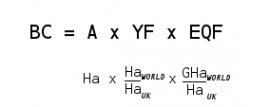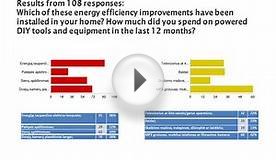Calculation of Ecological footprint
First, you calculate the yield factor for a particular type of land for a particular country (e.g. cropland in the UK, or forestry in Japan). This shows the relative productivity of a particular bit of land, so for example you can determine that cropland in the UK is x times as productive as cropland in Tibet.

Next, you need to calculate the biocapacity of that bit of land. Multiply the area (in hectares) by the yield factor, and by the equivalence factor. This latter factor represents the relative productivity of a particular type of land (e.g. cropland) to the world average productivity of all land. So you end up with an indication of the biocapacity that accounts for the area of land, the type of land, and the geographical location of the land.
Finally, you can calculate the ecological footprint of a particular nation / community / product. You multiply the yield and equivalence factors by the ratio of tonnage to yield for each type of land being used. The tonnage is the mass of products being consumed, whilst the yield is the number of tonnes per hectare that you would normally get from that country's land type. This all cancels out into a figure in global hectares.
You can then compare the global hectares of biocapacity (supply) to the global hectares of our footprint (demand), and estimate the extent of our ecological overshoot.
Footprinting a nation
For nations and other geographically defined groups, it's relatively easy to then calculate their ecological footprint. You know the levels of consumption, so you can calculate the impact that consumption has on the earth's resources.
The ecological footprint of a nation can then be calculated in one of two ways. The most simple is the mass balance approach: take data on the consumption in tonnes (or metres cubed for forestry) of all resources for the nation, and then run that through the equation above to arrive at the eco-footprint.


|
Magnesium Oil with ALOE VERA (Makes it less itchy) - Big 12Oz - Highly purified 100% Tested - SEE RESULTS OR MONEY-BACK - Best for Sore Muscles, Leg Cramps, Restless Legs Syndrome, Headache & Migraine Beauty (Seven Minerals)
|